Lowestoft, Suffolk, England, UK – Sunday, June 13th, 2010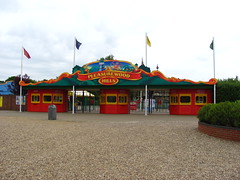
Winning an award for “Most Stereotypically British-Sounding Park Name”, Pleasurewood Hills is a small amusement park a few miles and a short bus ride south of Great Yarmouth. I arrived a good half hour prior to opening, the time spent waiting outside the gates making me regret not bringing my jacket that morning while I wondered if anyone else would show up. Truth be told, I was also slightly nervous how I would be received by patrons and/or security given the events that took place the previous day at Adventure Island. Minutes before opening a small crowd had finally amassed for the day, the gates opened, and we all made a rush for the first rides of the day. Of course by the time I made it to my destination, the dispersion of everyone else to other attractions was spread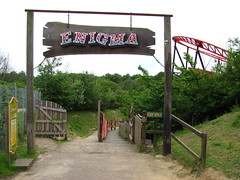 thin enough that I was the only one there.
thin enough that I was the only one there.
I think it was regardless a wise choice to not take any risks in getting to the Enigma first thing in the morning. As far as is known this is the only example of its model ever produced by Herr Schwarzkopf, which bears many likenesses to his other work such as a symmetrical, tiered track design that is intended to be viewed from a specific angle for maximal aesthetic enjoyment. Aside from a new figure-eight style layout that takes some inspiration from earlier Jumbo Jet blueprints in a more economical configuration, the primary distinguishing characteristic from Herr Schwarzkopf’s other work is a completely abysmal human capacity. A single, two car train was that that was all that was within any proximity of its red rails, as far as I know there are no additional carriages which must make queues exceedingly frustrating during peak season, but I anticipated there would be few problems today.
of its red rails, as far as I know there are no additional carriages which must make queues exceedingly frustrating during peak season, but I anticipated there would be few problems today.
 My first ride in the front seat ended up being shared with a similarly solitary enthusiast from Germany who apparently endured no heckling by security when he carried a massively expensive camera through the gates. I tried not to feel insecure about my little Canon point-and-shoot, which I reasoned lightweight cameras are better for traveling park activities and had nothing to compensate for anyway. Loaded into the ride and cameras secure we climbed up the tire drive lift, a sadly functional replacement for the old spiral drives. There’s a slight curve before reaching the top (I always wonder how do the catch fins get through the tires on these curved tracks?) we get a brief survey of the park from above the ride’s small gulch before twisting downward and back up along the first figure-eight.
My first ride in the front seat ended up being shared with a similarly solitary enthusiast from Germany who apparently endured no heckling by security when he carried a massively expensive camera through the gates. I tried not to feel insecure about my little Canon point-and-shoot, which I reasoned lightweight cameras are better for traveling park activities and had nothing to compensate for anyway. Loaded into the ride and cameras secure we climbed up the tire drive lift, a sadly functional replacement for the old spiral drives. There’s a slight curve before reaching the top (I always wonder how do the catch fins get through the tires on these curved tracks?) we get a brief survey of the park from above the ride’s small gulch before twisting downward and back up along the first figure-eight.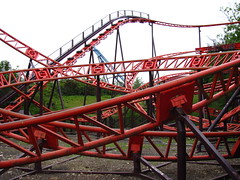
The layout that follows is some variation on the beginning, traversing the length of the footprint either with the s-curve of half an 8 or a straight return, with a helix thrown in the second half for good measure. Occasionally some positive forces are accumulated, accentuated by the strong angular motion that the smaller scale turns provide over larger brethren, and punctuated every now and again by an intermittent block brake (despite only one train operation; they never triggered).
How did Schwarzkopf figure out how to make a good block brake that doesn’t brake the flow of pacing forty years ago when most manufacturers today have to completely stop whatever action they were trying to direct to build an plateaued camelback hill with a 100 ft. long stretch of brakes over the top? Here there are just a couple of small calipers built on a section of curved track that would be naturally low-speed anyway, and I assume these were sufficient at bringing the train to a halt if need be. Why is it that if yesterday’s technology were used on today’s rides it would be an improvement?
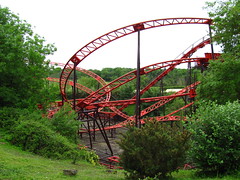 The feel of the track on this one is also quite distinctive (if you look outside the Schwarzkopf canon anyway…). There is not a single steel tube left unmolested by the track bender, something other manufacturers were loathe to do in favor of keeping straight or statically circular track wherever possible before B&M came along and officially made it standard practice. The track shows evidence of heartlining techniques with banking and radii constantly in flux, yet there’s also a joyful, haphazard feeling of the track design for the rider. It’s like in an early hand-built NoLimits track where the designer is aware that these tricks of calculus
The feel of the track on this one is also quite distinctive (if you look outside the Schwarzkopf canon anyway…). There is not a single steel tube left unmolested by the track bender, something other manufacturers were loathe to do in favor of keeping straight or statically circular track wherever possible before B&M came along and officially made it standard practice. The track shows evidence of heartlining techniques with banking and radii constantly in flux, yet there’s also a joyful, haphazard feeling of the track design for the rider. It’s like in an early hand-built NoLimits track where the designer is aware that these tricks of calculus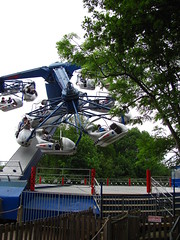 exist and sort of what a ‘correct’ track looks like, but with no means to actually implement these formulas they just have to eyeball it and make their best estimates. There’s a charm to it that can’t be beat, and I’m rather saddened that I didn’t cross paths with many other of Anton’s rides during my travels across Europe.
exist and sort of what a ‘correct’ track looks like, but with no means to actually implement these formulas they just have to eyeball it and make their best estimates. There’s a charm to it that can’t be beat, and I’m rather saddened that I didn’t cross paths with many other of Anton’s rides during my travels across Europe.
Having written more than should ever have been necessary for a ride of that stature, I moved on to explore the rest of the park where the next ride I came across appeared to be an incredibly strange mix between a HUSS Condor and an Enterprise. I’d never seen anything like it before, so naturally I had to give this device, dubbed Thunderstruck, a whirl. Looks proved to be deceiving, as the centrifugal force meant there wasn’t much more interesting going on in terms of sensation than would be found on a normal Condor, and without the large elevation change. I guess that makes it better described as an overly complicated Troika, good for some fun but not exactly a thrill ride.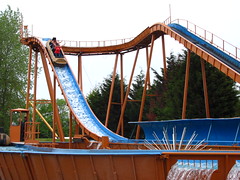
I gave a serious pause of contemplation for trying the Timber Falls log flume, appearing to be one of the park’s larger offerings and in a pretty new, clean condition as well, but decided against it on the count of some shields positioned next to the splashdown that deflected all the water back into the boats. Amazingly, despite the chilled weather there were a few patrons who found Timber Falls’ offer an acceptable one. To be honest I was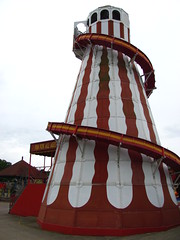 rather ashamed of myself, as hailing from northern Michigan I recall a time not long ago when I gladly rode Shivering Timbers seven or
rather ashamed of myself, as hailing from northern Michigan I recall a time not long ago when I gladly rode Shivering Timbers seven or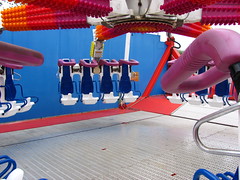 eight times in a row in 40°F weather wearing only a t-shirt. I seemed to have developed a greater sensitivity to the temperature while in Europe, possibly owing to my refusal to eat anything that would cost me money and had developed the metabolism of a boa constrictor.
eight times in a row in 40°F weather wearing only a t-shirt. I seemed to have developed a greater sensitivity to the temperature while in Europe, possibly owing to my refusal to eat anything that would cost me money and had developed the metabolism of a boa constrictor.
Instead I found comfort in a seat on the Wizzy Dizzy (love the name), a transportable KMG Afterburner. There was nothing at all remarkable about this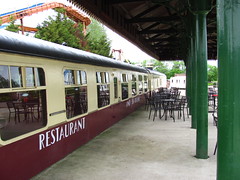 attraction that set it apart from the usual, but it was one of the better rides at the park. The helter-skelter was disappointingly closed (I promised myself I would ride at least one of these while in the UK but somehow that never happened), and I failed to cross paths with the boat dark ride. There were also some miniature trains running the property, as well as a cool art-deco cafe constructed inside a retired passenger train coach car. I ended up getting a ride across the park on a chairlift called the Merry-Go-Straight (seriously). It was a far slower exercise than walking across the park would have been, but it proffered some pleasant views plus dangling over a small lake in a small wooden bench affixed to a pencil-thick cable swaying in the wind was likely one of the bigger thrills the park had on offer.
attraction that set it apart from the usual, but it was one of the better rides at the park. The helter-skelter was disappointingly closed (I promised myself I would ride at least one of these while in the UK but somehow that never happened), and I failed to cross paths with the boat dark ride. There were also some miniature trains running the property, as well as a cool art-deco cafe constructed inside a retired passenger train coach car. I ended up getting a ride across the park on a chairlift called the Merry-Go-Straight (seriously). It was a far slower exercise than walking across the park would have been, but it proffered some pleasant views plus dangling over a small lake in a small wooden bench affixed to a pencil-thick cable swaying in the wind was likely one of the bigger thrills the park had on offer.
As I was surveying the landscape I concluded that Pleasurewood Hills was a far more pleasant park than I originally had expected. My mental image of the place was along the lines of a semi-permanent carnival set up over an empty field, and while to some degree that is what it is, it was done in a way that felt not as much ‘low-budget’ but rather ‘natural’. It’s like Lightwater Valley or Oakwood in that it’s a very green park with man-made objects used sparingly to decorate the midways (sans a signature world-class attraction). It’s not the elaborate botanic gardens of Alton Towers, just one of those uniquely British style parks where it wouldn’t seem out of place to see people having a picnic beneath a tree or playing cricket next to the roller coasters.
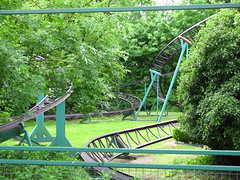 Upon my arrival at the other station I heard what at first seemed like a B&M roar, but soon deduced the sound to be coming from the couple hundred wheels rolling along steel I-beams on the Snake in the Grass, the park’s Tivoli family coaster. I hopped on in the back row and found an adequate experience awaited, the lift hill enclosed in a steel tunnel (is there a practical reason for this or is it just a random flourish?) and the rest of the double figure-eight track tucked between a dense thicket of trees and bushes. I might have given it a reride if that weren’t already included as part of your cycle. I did take the liberty of collecting a POV video, posted below.
Upon my arrival at the other station I heard what at first seemed like a B&M roar, but soon deduced the sound to be coming from the couple hundred wheels rolling along steel I-beams on the Snake in the Grass, the park’s Tivoli family coaster. I hopped on in the back row and found an adequate experience awaited, the lift hill enclosed in a steel tunnel (is there a practical reason for this or is it just a random flourish?) and the rest of the double figure-eight track tucked between a dense thicket of trees and bushes. I might have given it a reride if that weren’t already included as part of your cycle. I did take the liberty of collecting a POV video, posted below.
The final ride on my agenda was Pleasurewood Hills’ pride and joy, the Wipeout. I’m generally of the impression that Vekoma Boomerangs get way more flack than they deserve. I wouldn’t claim they’re the pièce de résistance of the coaster world, but whenever I’m on one I find them to be enjoyable enough in the moment. A fast and disorienting ride, nothing more nor less.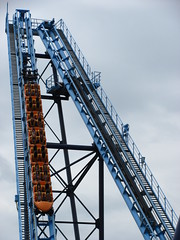 How can it be rough when the majority of track doesn’t even have any lateral motion to it? (Unless people think the steel rails get potholes…) I guess the bowl of the cobra roll is generally the main problem spot
How can it be rough when the majority of track doesn’t even have any lateral motion to it? (Unless people think the steel rails get potholes…) I guess the bowl of the cobra roll is generally the main problem spot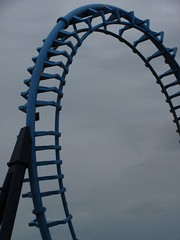 for most; especially at the peak of either inversion you can see the cars ‘snap’ from where it transitions from the vertical movement of the loop to the curve of the corkscrew without any lead room. But still, if you know it’s coming there’s no reasonable excuse to pretend you’re being thrown around like a ragdoll, at least not if your experiences with these rides are anything similar to mine. There’s always that epistemic uncertainty
for most; especially at the peak of either inversion you can see the cars ‘snap’ from where it transitions from the vertical movement of the loop to the curve of the corkscrew without any lead room. But still, if you know it’s coming there’s no reasonable excuse to pretend you’re being thrown around like a ragdoll, at least not if your experiences with these rides are anything similar to mine. There’s always that epistemic uncertainty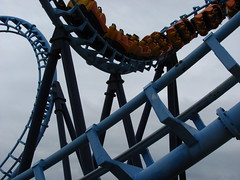 when two people on the internet compare how rough they think a ride is, isn’t there?
when two people on the internet compare how rough they think a ride is, isn’t there?
Anyway, I was able to get three or so rides on the Wipeout, all enjoyable, and it seemed much bigger and more thrilling when the rides you’ve been comparing it to are all barely over 50 ft. Not that 120 ft. is anything to sneeze at even when amongst giants. I rounded up one last ride on Enigma (which had acquired a sizeable wait; I was lucky to skip by most of it when a single rider was needed after a father found that his two kids were in the height range that required riding with an adult.
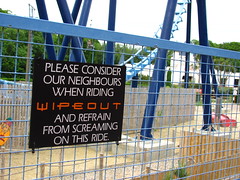 I sort of wish I had more time to spend in Pleasurewood Hills, as despite my original estimations that the two and a half hours I allowed myself would be spread thinly after rounding up the three coasters in a fifth of that time, I was sort of wishing that I didn’t need to leave to catch the next bus from Lowestoft back to Great Yarmouth so soon. Regardless, I had two more parks to do that day and I didn’t want to run short on time.
I sort of wish I had more time to spend in Pleasurewood Hills, as despite my original estimations that the two and a half hours I allowed myself would be spread thinly after rounding up the three coasters in a fifth of that time, I was sort of wishing that I didn’t need to leave to catch the next bus from Lowestoft back to Great Yarmouth so soon. Regardless, I had two more parks to do that day and I didn’t want to run short on time.






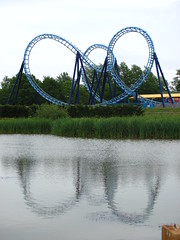

On snake in the grass there used to be a tunnel like a proper mountain but they started rebuilding it in 2010 but never finished it
I am very disappointed that the snake in the grass is closed now I love that ride even though everyone thought it was a kiddy ride it sure was alot of fun. I would like to know the problems that was about redoing it as I may be able to help